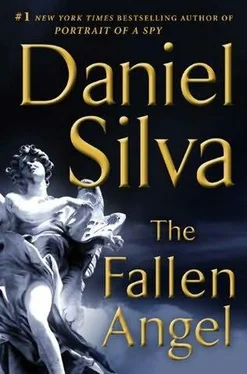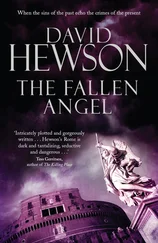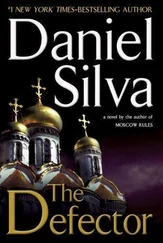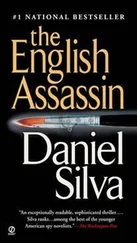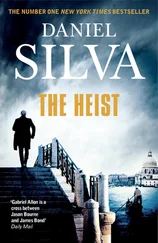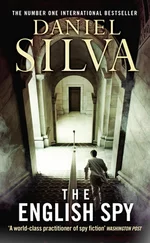“So far, so good,” Donati said as the helicopter rose swiftly into the air.
“Yes,” said Gabriel. “But now the fun begins.”
They headed eastward into the Judean Hills, above the winding staircase-like gorge separating Jerusalem from the sea. Gabriel pointed out some of the villages that had seen the worst fighting during Israel’s War of Independence; then Jerusalem appeared before them, floating, as though held aloft by the hand of God. The pope peered intently out his window as they crossed the city from west to east, new to old. As they passed over the Temple Mount, the golden Dome of the Rock sparkled in the midday sun. Gabriel showed the pope the Church of the Holy Sepulchre, the Church of the Dormition, and the Garden of Gethsemane.
“And your son?” asked the pope.
“There,” said Gabriel as they passed over the Mount of Olives.
The helicopter banked gently to the south and flew along the 1949 Green Line, now commonly referred to as the pre-1967 border. From the air, it was plain to see how the border had effectively dissolved after more than forty years of Israeli occupation. In the span of a few seconds, they passed over the mixed Jerusalem neighborhood of Abu Tor, the small West Bank Jewish settlement of Har Homa, and the Arab village of Beit Jala. Adjacent to Beit Jala was Bethlehem. Manger Square was easily visible from the distance, for it was crammed with several thousand people, each one waving a small Palestinian flag. On the roads leading into the city, not a car moved, only the trucks and jeeps of the IDF.
“This is where things are going to get political,” Gabriel told Donati. “It’s important to keep things moving, especially since the guest of honor will be the only male dressed entirely in white from head to toe.”
As the helicopter set down, President Mahmoud Abbas and the leadership of the Palestinian Authority waited on a dais outside the Church of the Nativity. “Welcome, Your Holiness, to the ancient land of Palestine,” Abbas exclaimed, loudly enough for the remark to be heard by the reporters standing nearby. “And welcome to Bethlehem and Jerusalem, the eternal and indivisible capital of Palestine.” The pope responded with a noncommittal nod and then greeted the rest of the delegation. Most were clearly pleased to be in his presence, but one, Yasser Abed Rabbo, a former leader of the terrorist Popular Front for the Liberation of Palestine, seemed far more intrigued by the bodyguard who never strayed more than a few inches from the pope’s shoulder.
Entering the church, the pope spent a few minutes in silent prayer at the Altar of the Nativity. Then he asked Abbas to show him the damage that had been done to the church in 2002, when a group of Palestinian terrorists seized the sacred Christian site in an effort to evade capture. At the conclusion of the ninety-three-day standoff, Israeli forces discovered forty explosive devices concealed within the church, while Franciscan clerics held hostage during the siege described how the Palestinian terrorists looted the church of gold icons and used pages of the Christian Bible for toilet paper. All this, however, was apparently news to Mahmoud Abbas. “The only damage done to the church,” he insisted, “was done by the Israelis. As you know, they are profoundly anti-Christian.”
“If that is the case,” the pope replied coolly, “why has the Christian population of Bethlehem fallen from ninety-five percent to just one-third? And why are Christians fleeing the territory controlled by the Palestinian Authority at an alarming rate?”
Abbas smiled weakly and looked at his wristwatch. “Perhaps, Your Holiness, it might be a good time to pay a visit to Dheisheh.”
The camp was located about a mile to the south of Bethlehem on a patch of land leased from the Jordanian government after the conclusion of the War of Independence. Originally, some three thousand Palestinians, mainly from Jerusalem and Hebron, lived there in tents. Now, more than sixty years later, the tents had been replaced by cinderblock structures, and the population of the camp had grown to nearly thirteen thousand registered refugees. With unemployment rampant, most were permanent wards of the United Nations, and the camp was a hotbed of militant activity. Even so, the residents cheered the pope as he walked the narrow streets with Gabriel at his side.
At the conclusion of the tour, in the camp’s dusty central square, the pope lamented what he described as “the terrible suffering of the Palestinian people.” But in an abrupt departure from his prepared text, he pointedly criticized the failure of three generations of Arab leadership to achieve a just and viable solution to the refugee crisis. “Those who would perpetuate human suffering in the service of politics,” he said solemnly, “must be condemned as strongly as those who would inflict it in the first place.”
With that, the pope blessed the crowd with a sweeping sign of the cross and climbed into an armored limousine for the short drive to Jerusalem. Entering the Jewish Quarter through the Dung Gate, he inserted a plea for peace between the stones of the Western Wall before making his way on foot through the streets of the Muslim Quarter to the Chain Gate, one of the eastern entrances to the Haram al-Sharif. A sign posted by the chief rabbinate of Israel warned that, in its opinion, Jews were forbidden to set foot on the Mount due to its sacredness.
“I never realized,” said the pope.
“It’s complicated, Holiness,” said Gabriel. “But in Israel, most things are.”
“Are you sure you want to come with me?”
“I’ve been here before.”
The pope smiled. “I shudder to think what would have happened to poor little Isaac if it wasn’t for you.”
“It was God who spared the boy. The Archangel Gabriel was only his messenger.”
“I hope he sees fit to spare me, too.”
“He will as long as you listen to me,” said Gabriel. “Things can go wrong here in a hurry. If I see something I don’t like—”
“We leave,” said the pope, cutting him off.
“Quickly,” said Gabriel.
Though the Waqf controlled the Noble Sanctuary itself, it did not control the entrances, which meant the Israeli government had been able to enforce the Vatican’s request that the Haram be closed for the pope’s brief visit. As a result, the delegation of Islamic dignitaries waiting on the steps leading to the Dome of the Rock numbered just forty. They included the Grand Mufti, the members of the Waqf’s Supreme Council, and several dozen armed security guards, many of whom had links to Palestinian and Islamic militant groups. Within minutes of the pope’s arrival, the mufti invited him to pray inside the Dome of the Rock, despite the fact the Waqf had assured the Vatican that no such invitation would be forthcoming. The pope diplomatically declined and then spent several minutes marveling at the building’s glorious mosaics and windows. Gabriel quietly pointed out the Arabic-language inscriptions that openly mocked Christian belief and invited all Christians to convert to Islam, which Muslims considered the final and decisive revelation of the word of God.
“Do you read Arabic?” the mufti asked.
“Nein ,” Gabriel replied in German.
The tour complete, the pope and the mufti adjourned to the garden for tea. Alone with the most powerful religious figure in the world, the keeper of Islam’s third-holiest shrine used the opportunity to expound upon his oft-stated theory that the Holocaust had never happened and that the Jews were secretly plotting to destroy the Dome of the Rock with the help of fundamentalist Christians from America. The pope listened in stoic silence, but in his public remarks afterward, he called the conversation “most enlightening.” Then, after delivering his planned apology for the murderous excesses of the Crusades, he pointed out that the Israelis were the first conquerors in the history of Jerusalem to leave the status quo of the Holy Mountain unchanged. As a result, he declared, Islam had a special duty to not only care for the mosques that stood on the surface of the Noble Sanctuary, but to protect the sacred ruins that lay beneath it as well.
Читать дальше
Конец ознакомительного отрывка
Купить книгу
